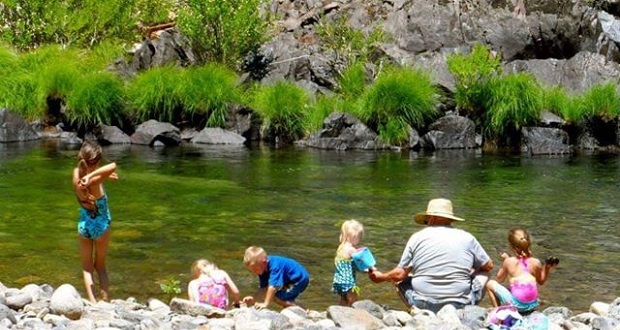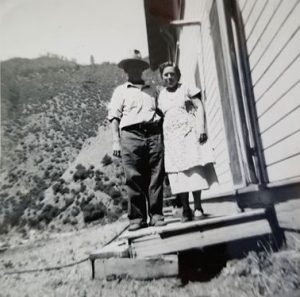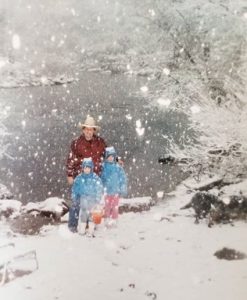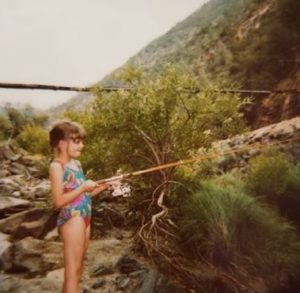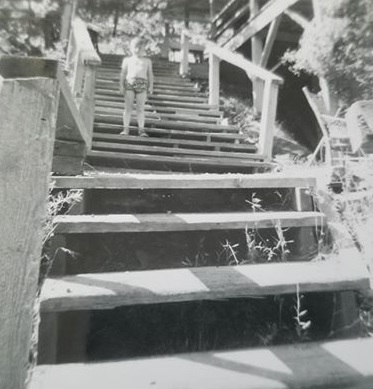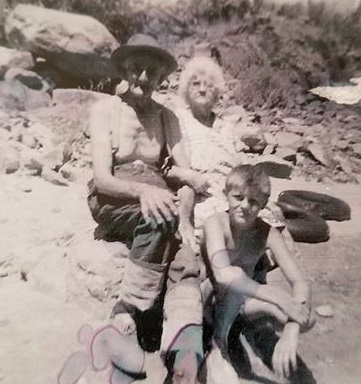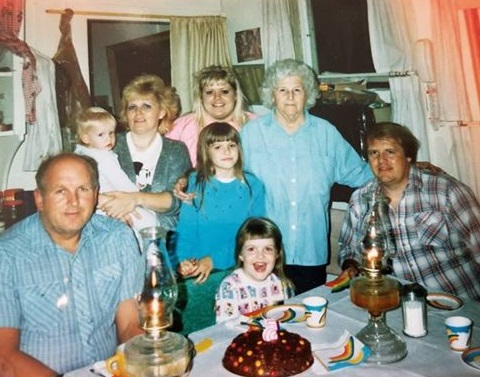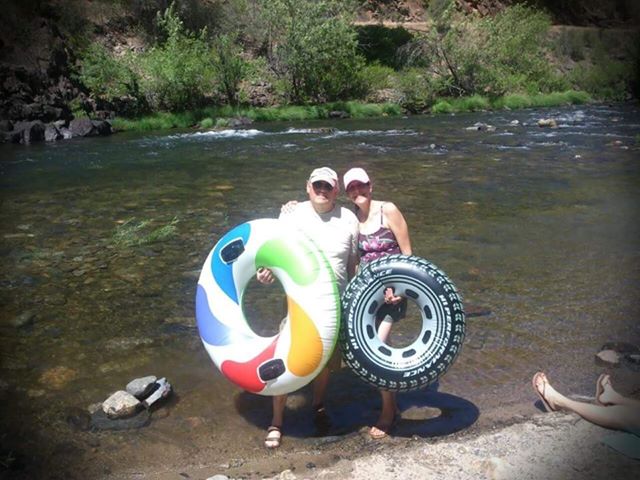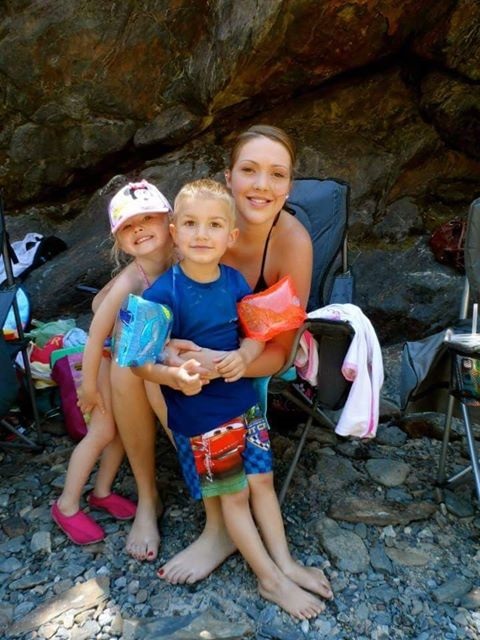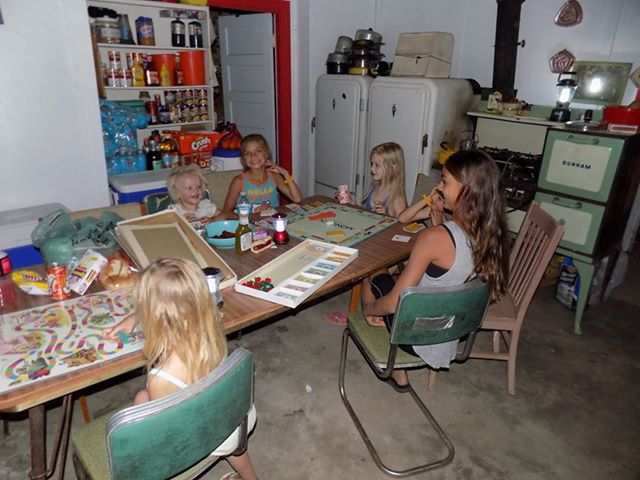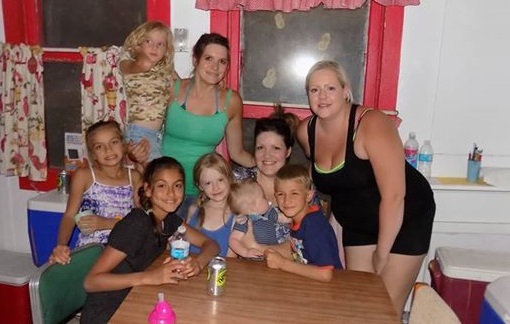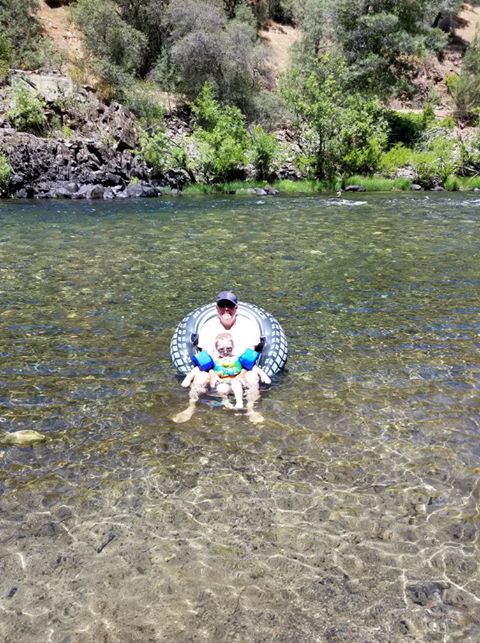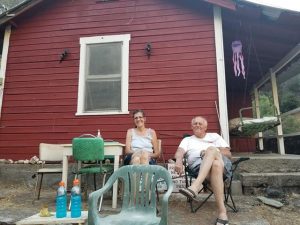
Linda and Steve Hakanson at their cabin, Independence Day week 2018
“The song of the river ends not at her banks, but in the hearts of those who have loved her.” — Buffalo Joe
MARIPOSA — The first time Steve ever set foot on the property, he didn’t really set foot. He was just a baby, one year old, riding on his father’s shoulders. That was nearly 70 years ago. Ever since, the family’s place on the Merced River has been a part of his soul.
Steve ran barefoot on the river’s rocky shores as a child, and learned to labor on its banks as a teen. When it came time to raise a family of his own, those children were brought up at the river, too. And their children now run barefoot on the shores.
The difference is, the cabin that stood for years burned in the Ferguson Fire, along with another family cabin close by. These and other losses remain unconfirmed by Cal Fire, but early on the families saw photographs in which the cabins appear to have been destroyed. Later, they saw the evidence, firsthand.
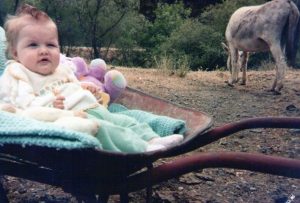
Rachel positioned in the same wheelbarrow that is believed to have survived the recent fire, even when the cabin did not
“Some of our earliest and fondest memories are of spending the summer at the cabin,” says Steve’s daughter Rachel Owens, speaking on behalf of the sisters. “We would cross the old swinging bridge and Jenny, the donkey, would be waiting on the other side under one of the shade trees to follow us up the road to the cabin.
“After a day of playing in the river we would lay out under the stars in the front yard and listen to our dad tell us stories of the days gone by.
“We are so thankful for the many years that we have had at this wonderful place. Our dad started coming here as a baby, brought us as babies, and we were able to bring our babies for a short time.”
Perfectly situated across the Merced River, about six miles up from Briceberg, the Hakanson family cabin was once one of two ancillary buildings to the barracks of an old limestone quarry.
Founded in 1924, the Yosemite Portland Cement Corporation was run by A. Emory Wishon of Fresno, who served continuously from 1925 to mid-1943. When he died of a heart attack in 1948, Wishon was known nationally as an eminent figure in the public utility field and a pioneer in the development of the power industry. By that time, he was president of PG&E (Madera Tribune, Jan. 5, 1948 obituary).
In those days, the railroad was still running and employed about 30 people, with a narrow gauge track on top of the grade near the quarry that ran for about a quarter of a mile.

Barracks for the quarry
They had a crushing plant and claimed there were 1,000 acres of limestone back then. The quarry ran until the early 1940s, when it wasn’t producing enough limestone to pay for the loan on the property and buildings. The property then exchanged hands a couple of times.
Among the structures bought and sold were a pair of two-story barracks for workers at the quarry, and various outbuildings to support the enterprise. One of the barracks was eventually converted into a hotel, with ten rooms on the top floor and ten rooms on the bottom.
By 1950, the railroad was defunct, and the quarry remained closed. That’s when southern California residents John Richardson and his wife Marie took a trip to Yosemite — except there was no place for the couple to stay.
They camped along the road and on rising the next day, surrounded by nearly indescribable beauty, the couple noticed a “For Sale” sign on the old hotel. John Richardson bought the place, along with several hundred acres of riverside property, for about $8,000.
The newly-dubbed Richardson Hotel made money for one season only — Memorial Day to Labor Day — so it was feast or famine for the owners, but they were happy.
They turned the other barracks building into a house, John worked for the Park Service and Yosemite Transportation, and they got by.
When things were really quiet in the winter months, John and Marie returned to their home in southern California where John could make do driving a school bus and with other sundry jobs. But they always returned to the river.
And that’s how Steve Hakanson came to be on his dad Emil’s shoulders beside the Merced River when he was just a year old. The Richardsons, John and Marie, were Steve’s aunt and uncle. Steve’s mom Flossie was John’s sister; Emil was his brother-in-law.
When Steve was just five, his dad passed away, leaving him and three older sisters to the care of mom, alone. After that, Steve says his Uncle Johnny became his surrogate dad. Whenever school was out, the Richardsons would pick Steve up from his home in southern California to spend time at the hotel on the river.
He was never a city boy, he says today… his bags were always packed and ready to go. Steve’s Uncle Dorry and Aunt Evelyn Richarson had a cabin, too, and they all had kids — the whole family would gather, with cousins galore.
In 1964, Uncle Johnny Richardson sold most of the property, including the barracks, but kept a couple of the outbuildings that had been converted to cabins.
The aunts and uncles, along with Steve’s mom and stepdad, purchased the little red cabin, which had been an office for the old Yosemite Portland Cement Company, and another on the property. They left the small sliding door from which workers were given their pay — a historic architectural feature that was also fun.
“Mom would go work at the hotel in the summer, cleaning beds and doing laundry. My grandparents were there, we’d throw rocks and play in the river and fish. We cousins all went hiking, explored all these acres and ponds and river.”
As the children got older, they helped more around the property.
“After we bought the place, I was 16 and a flood came down Miller’s Gulch. It almost washed the cabin away — it was hanging precariously over the bank. We worked three summers to fill it in. You have all the things you need right there — sand, rock, dirt. We’d work in the morning and evening, it was very hot in that canyon. We had crushed limestone to mix with cement — it was good strong stuff. We’d build up the wall and then build it higher.”
By 1989 Steve was married with kids. He had a landscape business in southern California, and they were tired of city living. Steve’s stepdad had passed away by this time, and mom Flossie was ready to get out of the city, too.
They sold their home down south and, while looking for the perfect place to live, Steve and his wife and three daughters (they would eventually have four) moved into the cabin. That was October of 1989. The oldest was 7 when they got to the river that time, and their youngest was just a year old. They stayed put until April of 1990, when the family Hakanson bought a house in Midpines.
And through the decades, even when the old hotel burned in 2003, as children grew and had children of their own, the families always returned to the cabin and the river. Fortunately, they were there most recently for a large and loving gathering over Independence Day this year.
The family is heartbroken that their beloved cabin is gone, but will never forget the sweet memories that were made there.
“I’ve always been in love with Mariposa, and I love the river,” says Steve. “I absolutely love it. It gets in your soul — the river is something I remember. And with the cabin, it’s not just that all the memories you had with grandparents, aunts and uncles, and all the other relatives — it’s remembering all the people who invested their lives in me and who had the opportunity to be there. It was a wonderful thing.”
Quick to point out that the loss of property is nothing in comparison with the loss of life experienced by firefighters during this trial, Steve and his wife have been escorted back into the canyon to see what’s left of the cabin.
Not much is left, at all. Except that wheelbarrow… the one Steve loaded up every day for three summers while they shored up the cabin that shored him up, all his life. The same wheelbarrow that held his kids for rides along the river’s shore. It’s still there. Maybe that’s a sign.
One of Steve’s favorite quotes explains how he feels, and the families all agree.
“The song of the river ends not at her banks, but in the hearts of those who have loved her.” – Buffalo Joe
All photos provided by the Hakanson family except as noted.
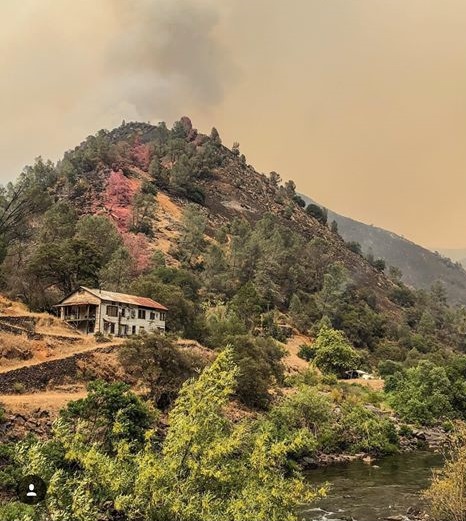
This photo was taken by Tod Sudmeier, EPN564, on on Saturday, July 14, 2018. The Hakanson’s cabin would have been standing at this point, positioned below and to the right of the barracks show here — though in this picture the family’s cabin is obscured by foliage (used by permission EPN564)
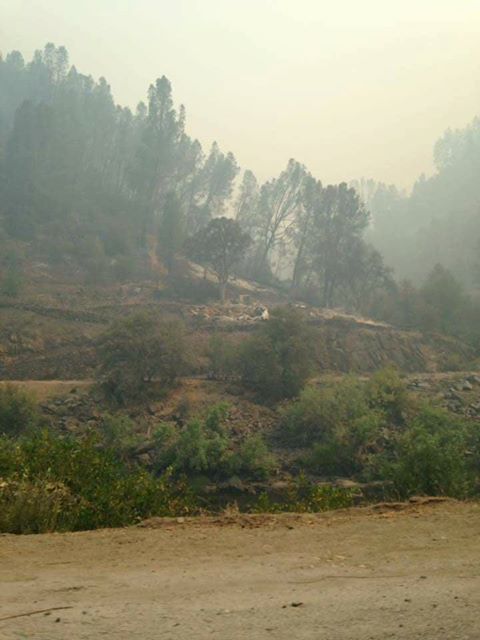
This photo taken on July 15, 2018 by Jarrod Blair shows the remains of the old barracks and the burned-out area where the Hakanson cabin once stood (Jarrod Blair)

